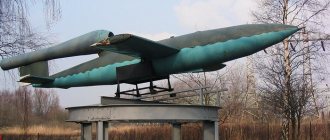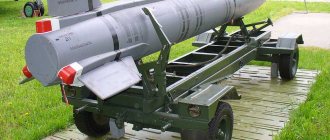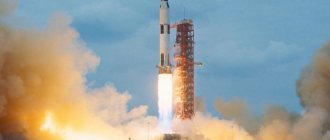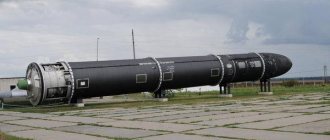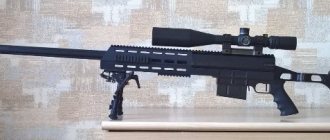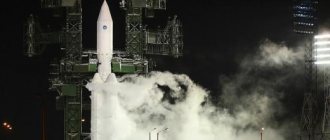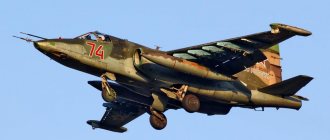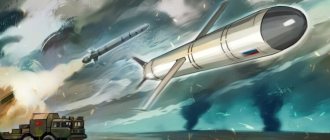Home » Real story » History of Wars » V-1 and its modifications
History of WarsLittle-known and unrealized projects of aircraft and other flying equipmentUnrealized and little-known weapons
The same Fonzeppelin 05/16/2019 1923
15
in Favoritesin Favoritesfrom Favorites 8
The German cruise missile V-1 (more correctly - Fi-103), it would seem, is known quite well. However, I noticed with interest/surprise that most Russian-language sources, when talking about this missile, of all its variants only mention the manned version of the Fi-103R Reichenberg. Few people mention the existence of a long-range variant of the Fi-103F. As a result, the reader gets the impression that the V-1 was produced in a single version.
What's wrong:
There were at least eight modifications of the V-1 in Germany alone (excluding American, Soviet, Japanese, French, Swedish and Argentine “unlicensed copies”). Some of them differed only in details; others had significant design differences and significant differences in performance characteristics. Not all were mass-produced, and some never made it off the design boards (and not only because they didn’t make it in time before the end of the war):
Fi-103A-1
Basic rocket model. In fact, it is exactly what is usually considered the famous V-1, first launched in the summer of 1944. All missiles fired at London before the Germans lost their launch sites in France were A-1 models.
Fi-103A-1 at the Australian War Memorial Museum
Fi-103A-1 was powered by a pulsating Argus As 109-14 engine and carried 610 liters (133 gallons) of E-1 jet fuel; this was enough to fly from 200 to 210 km. The speed was 670 km/h at an altitude of 1375 meters (4500 feet).
The warhead of the basic Fi-103A-1 weighed 850 kilograms and was equipped with ammatol 39A. By order of OKW, in an attempt to increase the destructive effect of the rocket, two hundred and fifty units were equipped with triallene 105, a mixture of explosives reinforced with aluminum powder. Since the version with trialene was no longer different from the base version, it was not considered a separate modification (however, the designation Fi-103A-2 is occasionally found, possibly referring specifically to it). In 1945, due to a shortage of high-quality explosives, some combat units were equipped with cheap engineering explosives based on dynamite.
V-2 ballistic missile
The family of ballistic missiles, created since the late 30s under the leadership of Wernher von Braun, bore the index “A” - “Aggregat”. The most famous of them - A-4, despite the digital designation, was the fifth in a series of projects, and first took off in the spring of 1942.
The structure of the V-2 hull included four compartments. The warhead was equipped with ammotol, the mass of the charge reached 830 kg. The control compartment contained a gyroscopic guidance system. The central, and largest, compartment was occupied by tanks with fuel and oxidizer. The fuel was an aqueous solution of ethyl alcohol, and liquefied oxygen acted as the oxidizer. Finally, the tail of the rocket was occupied by a liquid-propellant rocket engine.
Initially, the V-2 missiles were supposed to be launched from protected bunkers, but the air superiority gained by the Allied aircraft did not even allow the construction of fortified positions to be completed. As a result, the missilemen “worked” from mobile field positions.
To prepare such a launch site, it was enough to find a flat piece of terrain and install a launch pad on it.
Fi-103B-1
Even before the start of mass production of the V-1, the Ministry of Arms and Ammunition came to the conclusion that even this “cheap weapon” was too expensive for the Reich. An acute shortage of materials valuable in wartime conditions (including steel), caused by huge losses at the fronts and continuous bombing, forced savings on everything.
In an attempt to reduce the cost of the rocket, a simplified and cheaper version of the V-1 was developed. On it, the steel wing was replaced by a wooden one with a slightly larger span, and the nose fairing was made of plywood. The weight of the rocket decreased by about 38 kilograms, which resulted in a slight increase in range. All B-1 version missiles were equipped with ammatol.
The first Fi-103B-1s were launched in February 1945 over Antwerp. Most of the missiles assembled in the winter of 1944-1945 apparently belonged to this series.
Application
The first large formation of missile forces, the 65th Army Corps, was formed at the end of 1943. It included a regiment that was supposed to launch V-1s, but for the sake of conspiracy it was called “anti-aircraft artillery.” A week after the landing of troops in Normandy, “retaliation strikes” against Britain began.
As the Wehrmacht retreated from France, positions from which it was possible to strike at London were lost, and “drones” began to be used to fire at strategically important ports in Belgium. The shells turned out to be extremely unreliable - up to a quarter of the launched V-1s fell immediately after launch. Equally high was the percentage of rockets whose engines failed during flight.
The V-1s that reached Britain collided with balloons, were shot down by fighters, and were destroyed by anti-aircraft fire.
To continue the bombing of London and reduce the risk of meeting with V-1 interceptors, they tried to launch it from a He.111H-22 aircraft. Studies have shown that in such attacks up to 40% of V-1s were lost, and almost a third of the carrier aircraft were destroyed.
The V-2s entered service only in the fall of 1944. Although the warhead of the new weapon was no more powerful, and the accuracy of hits left much to be desired, the psychological impact of using the V-2 was incomparable. The ballistic missile was not detected by radar, and it was impossible to intercept it by fighters.
For some time it was believed that V-2s were guided by radar - this led to work on creating jammers.
They stopped in December 1944. It was supposed to create an artillery barrier on the intended flight path. But false reports sent by British intelligence turned out to be a good way to counter the V-2. They reported that German missiles were consistently missing London, going into flight.
The missilemen adjusted their targeting, and the V-2s began to hit sparsely populated suburbs. Intelligence, naturally, began to report accurate hits and great destruction. V-2 launches against London (designated as a priority target by Hitler personally) and Antwerp continued until the spring of 1945.
During the Battle of Remagen, there was an attempt to use the V-2 as a tactical weapon. The Fuhrer ordered with their help to destroy the railway bridge across the Rhine captured by the Americans. None of the fired missiles hit the bridge, and one deviated from the target by 60 kilometers.
Fi-103B-2
This modification of the rocket differed from the previous B-1 only in that its warhead was equipped with trialene. The missile's fuze has also been improved, with the goal of reducing the rate of failures after the V-1 crash. A number of sources mention that missiles of this modification bore a special marking in the form of a red “X” on the body of the warhead section. There is no exact data on what percentage of the B-series missiles were B-1s and what percentages were B-2s.
Fi-103B-2 at the Antwerp Museum
Advantages and disadvantages of such missiles
The V-2 became the superweapon of the Third Reich. The main advantage was that these missiles were ahead of their time, and the opponents of Nazi Germany did not have effective means of destroying this class of weapons.
In any army, the most expensive resource is personnel soldiers with complex specialties. Pilots are like that. And every flight to bomb a target in enemy territory is an inevitable risk of losing the pilot and his machine.
In the case of using the FAA family, this risk was reduced to zero. After all, the ammunition is still disposable and does not require regular repairs, maintenance or crew maintenance. In addition, the new weapons were much more difficult to detect and subsequently intercept.
One cannot exclude such an important point as a psychological factor. The use of the Third Reich's new superweapon—the FAA missile—against the British.
Despite the fact that missiles were indeed ahead of their time, they, like any, even the most modern weapons, were not without shortcomings.
For example, FAU 1 had one major drawback. The fact is that it did not move on the main engine for the entire flight. This created quite significant problems for the use of this type of weapon.
The FAA's launch vehicles were primarily used against the British, and they soon deployed a huge number of radars, observation posts and other missile defense systems to detect them.
After the FAU 1 was detected, a squadron of fighters was scrambled to intercept it or air defense systems were activated.
The Royal Air Force pilots used a rather interesting trick: they flew up to the rocket and pushed it to the side with their wing or “blown it away” with the air flow of their propeller.
In the second case, the FAA could be shot down by air defense systems, just like a regular aircraft.
FAU 2 had a flaw, from which two more followed. This weapon was very expensive, and the efficiency and accuracy of the FAU 2 control systems used were quite low.
In this photo you can see the compartments of the V1 rocket and see its simple structure. German engineers managed to create cheap and quite effective weapons to fight the enemy at long distances
Therefore, it was simply not profitable to destroy targets with missiles of this type; their production was comparable in cost to the production of all armored vehicles of the Third Reich in 1940.
Fi-103С-1
In an attempt to further reduce the cost of the missile, the S-1 version was developed. It retained the basic features of the B-1 - wooden wing, plywood nose cone, 610-liter fuel tank - but its warhead was replaced by a standard SC 800 aircraft high-explosive bomb (possibly an error - I could not find any mention of 800 kg high-explosive bombs on Luftwaffe weapons). Due to the use of a lighter warhead, the missile's flight range has increased slightly.
Missiles of this series may have been used against Antwerp and Brussels along with A and B series missiles. The exact number of S-1 missiles is unknown.
Fi-103B/C in the Munich Museum. This exhibit is assembled from parts of B and C-series missiles
Fi-103D-1
This version of the missile was developed in case of a chemical war. The warhead was supposed to carry a chemical explosive charge like sarin or tabun, and possibly be a pouring device that sprayed the contents as the rocket flew. In other respects, the D-1 was identical to the B-1, with the exception of a slightly lighter chemical warhead.
The D-1 modification was not mass-produced. The German command preferred not to mass produce chemical weapons delivery vehicles: because after the incident on September 8, 1939 (when Polish soldiers accidentally used chemical munitions, confusing them with conventional ones), they were afraid of inadvertently provoking the Allies to a catastrophic retaliatory chemical strike. As a result, projects for chemical weapons carriers were kept secret, and stockpiles of chemical weapons were evacuated to the rear - out of fear that some desperate general might arbitrarily provoke chemical Armageddon.
Fi-103E-1
The first “long-range” version of the V-1. In August 1944, advancing American troops captured German launch positions in Pas-de-Calais. The range of standard V-1 missiles was not enough to use them from more distant positions.
Trying to solve this problem, German engineers created a new version of the rocket. The weight of the warhead was reduced, and the steel lining of the warhead compartment was replaced with plywood. The released weight was used to increase the fuel tank capacity to 810 liters (i.e. almost a third compared to the A-1 version).
The E-1 missile was intended to be used against London from positions in Holland, but I have been unable to determine whether this version was mass-produced or used in combat. It is possible that work on the E-1 did not go beyond the prototype stage, since a 30% increase in fuel supply could hardly ensure effective shelling of London from more distant positions.
History of the creation of the FAU rocket
The development of liquid-fueled ballistic missiles began in Germany in 1926. People who were interested in designing rockets and studying other planets founded the Space Flight Society. Soon a young man named Wernher Von Braun, the future creator of FAU rockets, joined it.
Solid fuel rockets were used as a weapon in the bloody First World War - these are Le Prieux rockets, which were installed on airplanes and were intended to destroy German observation cylinders.
But Germany, under the terms of the Treaty of Versailles, could not develop missiles of this type. However, the documents of the Treaty of Versailles do not describe a ban on the construction of rockets with an engine using liquid rather than solid fuel. It was this loophole that the German command decided to take advantage of.
In 1929, the German government gave the military-industrial complex the task of finding the possibility of using liquid fuel rockets as weapons, and already in 1932 the first tests of missile prototypes took place.
By that time, the Space Flight Society, namely Wernher Von Braun, had created a working experimental prototype, presented to Colonel Walter Dornberger. Despite the fact that the possibilities of using the prototype were extremely small, the colonel became interested in it, and he invited the young designer to work under the command of the military.
Von Braun, like the vast majority of his colleagues in society, accepted this proposal, and in December 1934 the prototype A-2 rocket, powered by liquid oxygen and ethanol, was presented.
Despite the instability of this type of fuel and the availability of options for higher quality fuel mixtures, the choice was made on ethanol, as a cheap and mass-produced product.
The A-2 was successfully tested, and soon Von Braun's team began creating the A-3 and A-4 missiles, which became the prototypes of the V-1 and V-2.
The final creation of the A-4 rocket, which later became the basis for the development of the FAU 2, was completed in 1941.
FAU 2 launches were carried out until December 1942, however, after that they were stopped for economic reasons.
Fi-103F-1
The final “long-range” version of the V-1 and the last one put into mass production.
To begin with, the weight of the warhead was reduced to 530 kilograms. To compensate for the lack of power, it was decided to equip all F-1 series missiles with trialene (however, a shortage of explosives in the last months of the war led to the fact that late-release V-1 combat units were equipped with anything from ammatol to engineering dynamite). The rocket had a wooden wing, but its outer skin was covered with thin sheets of metal for strength and better preservation. The head fairing and warhead compartment were made of plywood.
The saved weight was used entirely to increase the fuel supply. The enlarged fuel tank held 1,025 liters of fuel - almost double that of the original A-1. Finally, the Argus pulsating engine of the As 109-14 model was replaced by a new, more powerful modification, the As 109-44.
All these measures made it possible to increase the missile's range to 345 kilometers using standard E-1 jet fuel. When replacing the fuel with the more efficient E-2, the missile's range increased to 370 kilometers.
Fi-103F-1 at the Imperial War Museum, London
F-1 modification missiles were used during the last “robotic blitz” in February-March 1945, when several hundred long-range projectiles were launched at London from positions in Holland. Initial plans called for stockpiling several thousand shells and launching a bombing campaign in parallel with the Ardennes counteroffensive, but shortages of fuel and materials, continuous Allied bombing and the general collapse of German industry delayed the start of the operation. As a result, the latest “robotic blitz” began after the Ardennes counter-offensive had ended in catastrophic failure, and had no effect - only 13 of the 275 missiles launched reached London. In April, advancing American troops occupied Dutch territory and the missile attacks finally ceased.
Fi-103 cruise missile. V-1. (V-1)
The German side used V-2 (A4) ballistic missiles and V-1 (Fi-103) cruise missiles on the Western Front during World War II. The fundamentally new weapon, despite a number of shortcomings, was effective from a military point of view. Moreover, the experience of its use in combat conditions for a long time clearly determined its power and leading place in the system of armed forces of the countries of the world. It is no coincidence that for three or four years after the victorious year of 1945, the leading countries of the world - the USA, USSR and Great Britain - had this type of missile in service. The V-2 and V-1 missiles are designed to accomplish their missions. The presence of two classes of weapons increases their effectiveness and expands the range of their combat use.
The damage caused by missiles during World War II was great - civilians were killed, industrial and civilian facilities were destroyed. Due to a number of circumstances, this type of weapon was not used on the Soviet-German front. The choice of targets for air attacks by the German side would not have been difficult - Murmansk, Leningrad, the Black Sea region. Work on the creation of a cruise missile began in Germany in the 1930-1940s. Flight tests were first conducted on December 24, 1942. The first engine installed on the Fi-103 was Argus 109-014. The cruise missile was an unmanned aerial vehicle with all the characteristics characteristic of an aircraft: a fuselage, a wing, horizontal and vertical tail surfaces with elevators and rudder. Naturally, Fi-103 flights were not dependent on meteorological conditions, and thus air strikes could be carried out at any time. The fuselage structure consisted of six sections. In addition to duralumin, plywood was used as a material.
An element of novelty in the design of the cruise missile was the autopilot. The flight program, drawn up on the ground, could no longer be changed after the rocket was launched. The accuracy of the missile hitting the target was low, the deviation was up to 15 m. The missiles fell on populated areas, destroying residential areas, as during massive bombings of German cities (Dresden, Hamburg...) by Allied aviation. Raising the question of whether the new weapon was effective, whether many or few people died, why few objects were destroyed in Great Britain, and so on, is immoral and pointless. Missiles, despite their “imperfection” (ideological definition), brought a lot of trouble to enemy territory. 2419 Fi-103 fell on London, 8696 on Antwerp, 3141 on Lüttich, etc.
The cruise missile was launched either using a catapult or from a carrier aircraft. Ar-234 and He-111 bombers were used.
In Germany, a total of 250,000 Fi-103 missiles were produced.
As a result of missile attacks from Fi-103, more than 5,800 people were killed and over 18 thousand people were injured. 123,000 buildings were destroyed. In the fight against cruise missiles, the British air defense forces achieved considerable success: 1,878 missiles were destroyed by anti-aircraft fire, 1,847 by fighter fire, and 232 were killed in collisions with barrage balloons.
Many samples of Fi-103 missiles and components came to the Soviet Union. But even before the end of the war, work was underway to create a cruise missile based on German documents obtained through intelligence channels. The KR-10KhN was created - a missile launched from a Tu-2 aircraft. Options were considered for using the Pe-8 aircraft with two missiles for this purpose. Domestic missiles have not received practical use.
Characteristics of V-1:
Arsenal watch
- Brief technical characteristics
- Length, m: 7.75
- Wingspan, m: 5.3 (later 5.7)
- Fuselage diameter, m: 0.85
- Height, m: 1.42 (1.55)
- Curb weight, kg: 2160
- Engine: 1 Argus As 014 thruster with a thrust of 2.9 kN (296 kgf)
- Maximum flight speed: 656 km/h (approx. 0.53M); the speed increased as the vehicle became lighter (with fuel consumption) - up to 800 km/h (approx. 0.65M).
- Maximum flight range, km: 286
- Service ceiling, m: 2700—3050 (in practice I flew at altitudes from 100 to 1000 meters)
- Warhead weight, kg: 700—1000, Ammotol consumable
- Fuel consumption, l/km: 2.35
- Tank capacity, l: 550-640, gasoline (80-octane).
- Circular probable deviation (calculated), km: 0.9
(presumably) Fi-103G
At the beginning of 1945, work was still ongoing in Peenemünde on improved models of the V-1. The model closest to implementation was known as the “500-kilometer version,” and would probably have been designated Fi-103G.
On this rocket model, the volume of the fuel tank was supposed to be increased to 1200 liters. The use of E-2 fuel and the As 109-44 engine would provide a flight range of about 450–470 kilometers. This would make it possible to fire at London directly from German territory. Since the supply of compressed air (which powered the rudders and autopilot of the rocket) in a standard spherical tank was not enough for such a long flight, and there was not enough space to install a larger tank, the new model had to receive a primitive compressor powered by the engine.
The “500-kilometer version” was not ready by the end of the war and did not enter mass production. An unfinished prototype was captured by Allied forces at the Mittelwerk factory.
America is learning from experience
In November 1945, the International Military Tribunal began in Nuremberg. The victorious countries tried war criminals and members of the SS. But neither Wernher von Braun nor his rocket team were in the dock, although they were members of the SS party.
The Americans secretly transported the “missile baron” to US territory.
And already in March 1946, at the test site in New Mexico, the Americans began testing V-2 missiles taken from Mittelwerk. Wernher von Braun supervised the launches. Only half of the launched "Revenge Missiles" managed to take off, but this did not stop the Americans - they signed hundreds of contracts with former German rocket scientists. The US administration’s calculation was simple: relations with the USSR were quickly deteriorating, and a carrier for a nuclear bomb was required, and a ballistic missile was an ideal option.
In 1950, a group of “rocket men from Peenemünde” moved to a missile test site in Alabama, where work began on the Redstone rocket. The rocket almost completely copied the A-4 design, but due to the changes made, the launch weight increased to 26 tons. During testing, it was possible to achieve a flight range of 400 km.
In 1955, the SSM-A-5 Redstone liquid-propellant operational-tactical missile, equipped with a nuclear warhead, was deployed at American bases in Western Europe.
In 1956, Wernher von Braun heads the American Jupiter ballistic missile program.
On February 1, 1958, a year after the Soviet Sputnik, the American Explorer 1 was launched. It was delivered into orbit by a Jupiter-S rocket designed by von Braun.
In 1960, the “rocket baron” became a member of the US National Aeronautics and Space Administration (NASA). A year later, under his leadership, the Saturn rockets, as well as the Apollo series spacecraft, were being designed.
On July 16, 1969, the Saturn 5 rocket launched and, after 76 hours of flight in space, delivered the Apollo 11 spacecraft into lunar orbit.
On July 20, 1969, astronaut Neil Armstrong set foot on the surface of the Moon.
Turbojet Fi-103, FGZ 76B
At the end of the war, Peenemünde engineers proposed radically improving the performance of the Fi-103 by replacing the Argus pulsejet engine with a small turbojet engine. At the cost of a slight increase in cost, it seemed possible to solve two key problems of the rocket: wasteful fuel consumption and high drag.
A sketch of a turbojet version of the V-1 was prepared, powered by a compact Porsche 109-005 turbojet engine. Developing a thrust of 4.9 kilonewtons (about ¾ more than the standard Argus), the engine would provide a theoretical speed of about 900 kilometers per hour with a flight range of up to 700 kilometers. BMW received an alternative order for a compact turbojet engine.
Such an increase in characteristics, firstly, would greatly complicate the interception of projectile aircraft (at a speed of about 800-900 km/h they would be practically invulnerable to piston fighters), and secondly, it would allow bombing London from such distant positions as Hamburg . According to some data, to improve accuracy, it was planned to equip the turbojet version with a radio command control system, tracking its flight using transponder signals. However, although the 109-005 engine was manufactured and tested, work on the FGZ 76B did not go beyond preliminary design.
